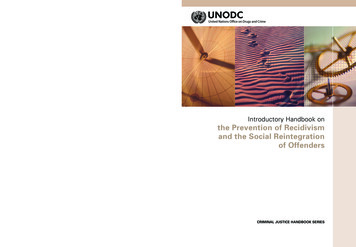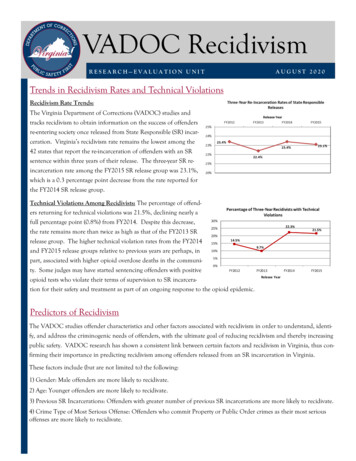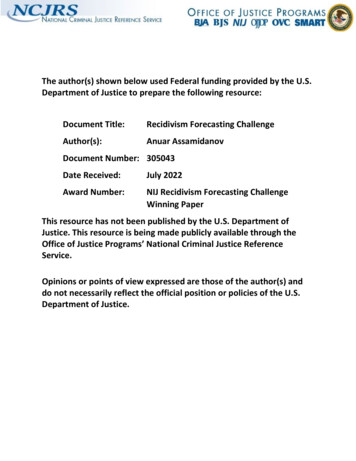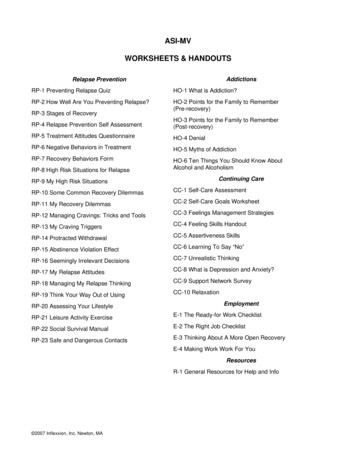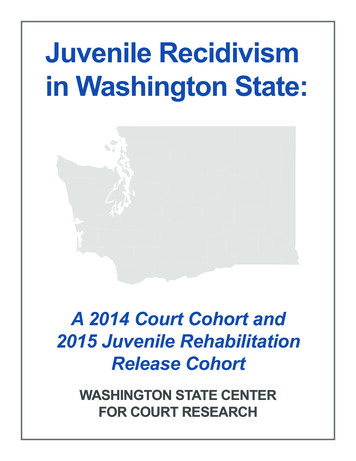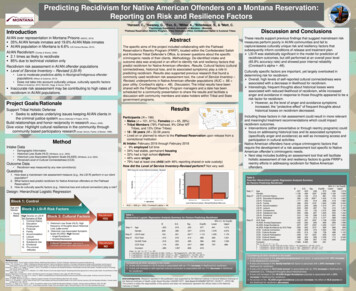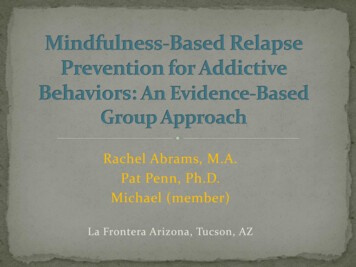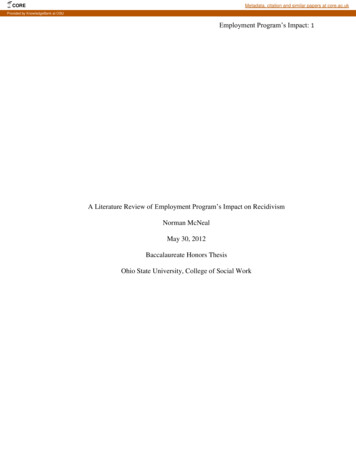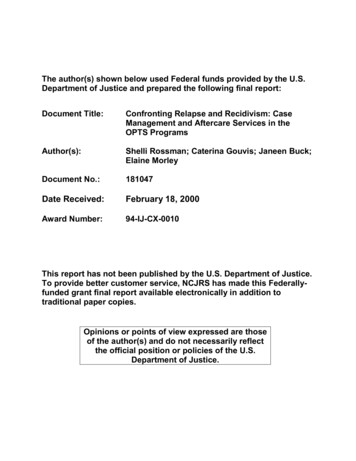
Transcription
The author(s) shown below used Federal funds provided by the U.S.Department of Justice and prepared the following final report:Document Title:Confronting Relapse and Recidivism: CaseManagement and Aftercare Services in theOPTS ProgramsAuthor(s):Shelli Rossman; Caterina Gouvis; Janeen Buck;Elaine MorleyDocument No.:181047Date Received:February 18, 2000Award Number:94-IJ-CX-0010This report has not been published by the U.S. Department of Justice.To provide better customer service, NCJRS has made this Federallyfunded grant final report available electronically in addition totraditional paper copies.Opinions or points of view expressed are thoseof the author(s) and do not necessarily reflectthe official position or policies of the U.S.Department of Justice.
G RELAPSE AND RECIDIVISM:AND AFTERCAREPROGRAMSThe Urban Institute2100 M Street, N.W.Washington, DC 20037nay 21, 1999This document is a research report submitted to the U.S. Department of Justice. This reporthas not been published by the Department. Opinions or points of view expressed are thoseof the author(s) and do not necessarily reflect the official position or policies of theU.S. Department of Justice.Shelli RossmanCaterina GouvisJaneen BuckElaine Morley
TABLE OF CONTENTSEXECUTIVESUMMARY . . . . . . . . . . . . . . . . . . . . . . . . . . . . . . . . . . . . . . . . . . . . . . . . . . . . . .Overview . . . . . . . . . . . . . . . . . . . . . . . . . . . . . . . . . . . . . . . . . . . . . . . . . . . . . . . . . . . . . .Key Findings . . . . . . . . . . . . . . . . . . . . . . . . . . . . . . . . . . . . . . . . . . . . . . . . . . . . . . . . . . .CaseManagement . . . . . . . . . . . . . . . . . . . . . . . . . . . . . . . . . . . . . . . . . . . . . . . . .Supervision and Monitoring . . . . . . . . . . . . . . . . . . . . . . . . . . . . . . . . . . . . . . . . .ServiceProvision . . . . . . . . . . . . . . . . . . . . . . . . . . . . . . . . . . . . . . . . . . . . . . . . . .Systems Integration and Program Institutionalization . . . . . . . . . . . . . . . . . . . . . .Chapter 1: The Opportunity to Succeed Initiative . . . . . . . . . . . . . . . . . . . . . . . . . . . . . . . . .TheOPTSModel . . . . . . . . . . . . . . . . . . . . . . . . . . . . . . . . . . . . . . . . . . . . . . . . . . . . . . .The OPTS Sample . . . . . . . . . . . . . . . . . . . . . . . . . . . . . . . . . . . . . . . . . . . . . . . . . . . . . .The Research Design . . . . . . . . . . . . . . . . . . . . . . . . . . . . . . . . . . . . . . . . . . . . . . . . . . . .Datasources . . . . . . . . . . . . . . . . . . . . . . . . . . . . . . . . . . . . . . . . . . . . . . . . . . . .TheScopeofThisReport . . . . . . . . . . . . . . . . . . . . . . . . . . . . . . . . . . . . . . . . . . . . . . . .1133568111113131417Chapter 2: The Primary Partnerships and Case Management Services . . . . . . . . . . . . . . . 19The Primary Partnerships: Lead Service Agencies and Community-Based Corrections19Offices . . . . . . . . . . . . . . . . . . . . . . . . . . . . . . . . . . . . . . . . . . . . . . . . . . . . . . . . .CaseManagement . . . . . . . . . . . . . . . . . . . . . . . . . . . . . . . . . . . . . . . . . . . . . . . . . . . . . . 22ServicePianning . . . . . . . . . . . . . . . . . . . . . . . . . . . . . . . . . . . . . . . . . . . . . . . . . 22ServiceProvision . . . . . . . . . . . . . . . . . . . . . . . . . . . . . . . . . . . . . . . . . . . . . . . . . 25Monitoring Client Progress . . . . . . . . . . . . . . . . . . . . . . . . . . . . . . . . . . . . . . . . . 33Client Satisfaction . . . . . . . . . . . . . . . . . . . . . . . . . . . . . . . . . . . . . . . . . . . . . . . . . . . . . . 47Case Management Challenges . . . . . . . . . . . . . . . . . . . . . . . . . . . . . . . . . . . . . . . . . . . . . 48Chapter 3: Substance Abuse Treatment . . . . . . . . . . . . . . . . . . . . . . . . . . . . . . . . . . . . . . . . .Clients’ Presenting Profiles . . . . . . . . . . . . . . . . . . . . . . . . . . . . . . . . . . . . . . . . . . . . . . .The Spectrum of Substance Abuse Treatment . . . . . . . . . . . . . . . . . . . . . . . . . . . . . . . . .Self-Help Groups . . . . . . . . . . . . . . . . . . . . . . . . . . . . . . . . . . . . . . . . . . . . . . . . . . . . . . .Outpatient Treatment . . . . . . . . . . . . . . . . . . . . . . . . . . . . . . . . . . . . . . . . . . . . . . . . . . . .Residential Treatment . . . . . . . . . . . . . . . . . . . . . . . . . . . . . . . . . . . . . . . . . . . . . . . . . . .Detoxification Programs . . . . . . . . . . . . . . . . . . . . . . . . . . . . . . . . . . . . . . . . . . . . . . . . .Challenges to Providing Substance Abuse Treatment . . . . . . . . . . . . . . . . . . . . . . . . . . .5454576063677374Chapter 4: Employment Services . . . . . . . . . . . . . . . . . . . . . . . . . . . . . . . . . . . . . . . . . . . . . .Employment Service Providers . . . . . . . . . . . . . . . . . . . . . . . . . . . . . . . . . . . . . . . . . . . .Challenges to Providing Employment Services . . . . . . . . . . . . . . . . . . . . . . . . . . . . . . . .787886Chapter-5: Housing . . . . . . . . . . . . . . . . . . . . . . . . . . . . . . . . . . . . . . . . . . . . . . . . . . . . . . . . . .Transitional Housing . . . . . . . . . . . . . . . . . . . . . . . . . . . . . . . . . . . . . . . . . . . . . . . . . . . .Crisis Shelter . . . . . . . . . . . . . . . . . . . . . . . . . . . . . . . . . . . . . . . . . . . . . . . . . . . . . . . . . .9193951This document is a research report submitted to the U.S. Department of Justice. This reporthas not been published by the Department. Opinions or points of view expressed are thoseof the author(s) and do not necessarily reflect the official position or policies of theU.S. Department of Justice.
Permanent Housing and Housing Assistahce . . . . . . . . . . . . . . . . . . . . . . . . . . . . . . . . . .Challenges to. Providing Housing Services . . . . . . . . . . . . . . . . . . . . . . . . . . . . . . . . . . .9697Chapter 6: Family Strengthening and Life Skills Services . . . . . . . . . . . . . . . . . . . . . . . . . .99100Skills Building Services . . . . . . . . . . . . . . . . . . . . . . . . . . . . . . . . . . . . . . . . . . . . . . . . .106Domestic Violence Services . . . . . . . . . . . . . . . . . . . . . . . . . . . . . . . . . . . . . . . . . . . . .107Family Outreach Efforts . . . . . . . . . . . . . . . . . . . . . . . . . . . . . . . . . . . . . . . . . . . . . . . . .Challenges to Providing Family Strengthening and Life Skills Services . . . . . . . . . . . 108Chapter 7: Health Care . . . . . . . . . . . . . . . . . . . . . . . . . . . . . . . . . . . . . . . . . . . . . . . . . . . . .Medical and Mental Health Services . . . . . . . . . . . . . . . . . . . . . . . . . . . . . . . . . . . . . . .Challenges to Serving OPTS Clients . . . . . . . . . . . . . . . . . . . . . . . . . . . . . . . . . . . . . . .111111114F .Chapter& LessonsLearned119CaseManagement . . . . . . . . . . . . . . . . . . . . . . . . . . . . . . . . . . . . . . . . . . . . . . . . . . . . .120122Service Planning . . . . . . . . . . . . . . . . . . . . . . . . . . . . . . . . . . . . . . . . . . . . . . . .123Familiarity With Core Services . . . . . . . . . . . . . . . . . . . . . . . . . . . . . . . . . . . . .CrisisManagement . . . . . . . . . . . . . . . . . . . . . . . . . . . . . . . . . . . . . . . . . . . . . . 124Recommendations for Strengthening Case Management . . . . . . . . . . . . . . . . . 126Systems Integration: The OPTS Lead Agency and the Criminal Justice System 128Establishing OPTS Within the Criminal Justice System . . . . . . . . . . . . . . . . . .128129Institutionalizing Roles and Responsibilities .132Supervision of Substance-Abusing Offenders .Recommendations for Strengthening Supervision and Criminal Justice Systems133Integration . . . . . . . . . . . . . . . . . . . . . . . . . . . . . . . . . . . . . . . . . . . . . . .ServiceNetwork . . . . . . . . . . . . . . . . . . . . . . . . . . . . . . . . . . . . . . . . . . . . . . . . . . . . . . . 136Recommendations for Strengthening Service Networks . . . . . . . . . . . . . . . . . . 138REFERENCES . . . . . . . . . . . . . . . . . . . . . . . . . . . . . . . . . . . . . . . . . . . . . . . . . . . . . . . . . . . . .APPENDIX AAPPENDIX B.APPENDIX CAPPENDIX DTampa MaterialsKansas City MaterialsSt . Louis MaterialsAPPENDIX E.11This document is a research report submitted to the U.S. Department of Justice. This reporthas not been published by the Department. Opinions or points of view expressed are thoseof the author(s) and do not necessarily reflect the official position or policies of theU.S. Department of Justice.141
LIST OF 8XHIBITSExhibit 1-1 : The OPTS Evaluation Model . . . . . . . . . . . . . . . . . . . . . . . . . . . . . . . . . . . . .15Exhibit 2- 1: Primary Partnerships . . . . . . . . . . . . . . . . . . . . . . . . . . . . . . . . . . . . . . . . . . . . 19Exhibit 2-2: Overview of OPTS Collaborative Service Delivery Structure. by Site . . . . . 26Exhibit 2-3: In-Person Contact With Case Manager . . . . . . . . . . . . . . . . . . . . . . . . . . . . .36Exhibit 2-4: Home Visits . . . . . . . . . . . . . . . . . . . . . . . . . . . . . . . . . . . . . . . . . . . . . . . . . . 37Exhibit 2-5: PO Contact: Comparing OPTS Clients to Routine Supervision . . . . . . . . . . . 39Exhibit 2-6: Average Number of Drug Tests. per Client .44Exhibit 2-7: Clients’ Perception of Case Managers . . . . . . . . . . . . . . . . . . . . . . . . . . . . . . .47Exhibit 2-8: Clients’ Perception of Probatioflarole Officers .48Exhibit 3-1:Exhibit 3-2:Exhibit 3-3:Exhibit 3-4:Exhibit 3-5:Drug Use History of OPTS Clients . . . . . . . . . . . . . . . . . . . . . . . . . . . . . . . . .55Prevalent Patterns of Drug Use for OPTS Clients .56Substance Abuse Treatment Providers. by Treatment Type and Site . . . . . . . 58Substance Abuse Services Used by Clients . . . . . . . . . . . . . . . . . . . . . . . . . .59Duration. Intensity. and Short-Term Outcomes of Substance AbuseTreatment . . . . . . . . . . . . . . . . . . . . . . . . . . . . . . . . . . . . . . . . . . . . . . . . . . . . 62Exhibit 4-1 : Employment-Related Problems Reported by OPTS Clients . . . . . . . . . . . . . 79Eshibit 4-2: Referrals for Employment Assistance. by Site . . . . . . . . . . . . . . . . . . . . . . . . 80Exhibit 5-1 : Referrals for Housing Services. by Site . . . . . . . . . . . . . . . . . . . . . . . . . . . . .92Exhibit 6-1 : Referrals for Family Strengthening. Life Skills. and Self Sufficiency.by Site . . . . . . . . . . . . . . . . . . . . . . . . . . . . . . . . . . . . . . . . . . . . . . . . . . . . . . .Exhibit 6-3: Client Participation in Parenting Skills by Site . . . . . . . . . . . . . . . . . . . . . . .101103Exhibit 7-1 : Referrals for Health Care . by Site . . . . . . . . . . . . . . . . . . . . . . . . . . . . . . . . . .112.111This document is a research report submitted to the U.S. Department of Justice. This reporthas not been published by the Department. Opinions or points of view expressed are thoseof the author(s) and do not necessarily reflect the official position or policies of theU.S. Department of Justice.
EXECUTIVE SUMMARYOverviewThe Opportunity to Succeed (OPTS) program was designed to reduce substance abuserelapse and criminal recidivism by providing comprehensive aftercare services to felonyoffenders who have alcohol and drug offense histories. Enrollment in OPTS was anticipated toimprove access to, and.utilization of, needed community-based services by eligibleprobationers/parolees. In addition to supporting sobriety and reducing criminal activity, OPTSservices were expected to promote pro-social attitudes and behaviors among participants,resulting in such desirable outcomes as gainful employment and responsible family/domesticarrangements.The Opportunity to Succeed MissionOpportunity to Succeed programs are intended to deliver community-based services that promote sobriety, lawabiding. and other pro-social behavior in adult, substance-abusing felons. The program rationale is that suchoffenders are less likely to relapse and engage in hture crimes if they are exposed to a comprehensive suite ofaftercare services (including substance abuse treatment, counseling, and skills-building activities), as well asgraduated sanctions that include incentives for positive behavior and penalties for failure to comply withprogram requirements. Service delivery is structured around case management, involving collaborativepartnerships between a lead service agency and the local probatiowparole office in each demonstration site.I1OPTS programs were initiated in 1994 as three-year demonstrations in five communities - Kansas Cit)?,MO; New York City, NY; Oakland. CA; St. Louis, MO; and Tampa, FL. Theproyam model \\!as developed by The National Center on Addiction and Substance Abuse( C.AS.4): both program implementation and evaluation occurred under CASA's administrativeo\.crsight. The demonstration programs were funded by the Robert Wood Johnson Foundation( Rii.1 I and the Bureau of Justice Assistance at the U.S. Department of Justice. OPTS programscontinued in three of the original sites beyond the demonstration phase, which concluded inSummer. 1997. The National Institute of Justice (NIJ) and RWJ funded The Urban Institute'se\.aluation of OPTS implementation and impact in three communities -- Kansas City, MO; St.Louis. 310: and Tampa, FL.OPTS pairs local probatiowparole departments -- offices of the Missouri Department of('orrections i n Kansas City and St. Louis, and the Florida Department of Corrections in Tampa -\\ i t h icad s e n ice azencles that provide case management and other social services. The primarys c n ice pro\ iders -- The National Council on Alcoholism and Drug Dependence (Kansas City),tht' Drug Abuse Comprehensive Coordinating Office (Tampa), and Lutheran Family andChildren's Sen,ices (St. Louis) -- directly delivered some treatment and supportive services toThis document is a research report submitted to the U.S. Department of Justice. This reporthas not been published by the Department. Opinions or points of view expressed are thoseof the author(s) and do not necessarily reflect the official position or policies of theU.S. Department of Justice.
adult probationer/parolees (as well as provided limited assistance to their family or domesticnetworks), in addition to referring OPTS clients to other service providers with whom the siteshad established MOUs or close working relations.The research used an experimental model that randomly assigned eligible felons to eitherthe OPTS program (treatment group) or routine supervision (control group). Programimplementation was documented by rt searchers using a number of techniques, including fieldvisits to directly observe program activities; one-on-one interviews and small group discussionswith staff, and separately with clients; and secondary analysis of program materials (e.g.memoranda of agreement, brochures, newsletters).This report describes the major components of the OPTS model, including aspects of casemanagement and supervision, as well as core services offered to OPTS clients in each of the fivecore domains in the three selected sites (see Morley et al., 1995, 1998; and Rossman et al.,1998a, 1998b, for other OPTS documentation reports).OPTS Core ServicesSubstance abuse treatment, ranging from 12-step programs through intensive residential placements,is a key component of the OPTS model.Emdovment services that assist clients in finding and maintaining legitimate employment.HousinP. including adequate, drug-free supportive living situations, such as halfway houses, grouphouses. and apartments to share, to assist clients in avoiding relapse.Familv strengthening services, such as parenting classes, family counseling, anger management,and domestic violence counseling.Health and mental health services. ranging from regular check-ups to specialized care when needed,are envisioned since substance abusers often have a wide variety of physical and mental healthproblems.Although the model calls for the provision of these core senices, it does not expect that each OPTS client willrequire the full spectrum of support Rather. senices are to be provided on an as-needed basis. The exceptionto this is the substance abuse treatment. which is a mandatory requirement for all participants.This report also assesses selected service utilization attributes and outcomes, includingsuch considerations as: 1 ) the use of specific categories of services (e.g., housing, family skillstraining. education or training programs); 2 ) the variety and comprehensiveness of servicessupporting individuals; 3) the service intensity, ].e., the number of contacts and duration ofutilization by senice type; and 4)recipients’ reported level of satisfaction with the services theyrecei \.ed.2This document is a research report submitted to the U.S. Department of Justice. This reporthas not been published by the Department. Opinions or points of view expressed are thoseof the author(s) and do not necessarily reflect the official position or policies of theU.S. Department of Justice.
Key FindingsThere was a high degree of variation among the sites in terms of programimplementation, consistent with the model’s intent to allow flexibility and autonomy in localdecision making and practices. For example, sites were expected to use existing communitybased resources, in preference to developing their own services. Thus, it is not surprising that thesuites of services and mix of providers varies dramatically across the three programs, as thesereflected the extant service networks and capacities in Kansas City, St. Louis, and Tampa. Othersite variations likely resulted from the visions, internal organizational structures, and decisionmaking of the lead agencies and/or the partnering probation and parole agencies regarding theroles and responsibilities of their respective staffs. For example, St. Louis was the only one of thethree sites to use a team approach that co-located case managers, POs, and core service providersfrom the substance abuse treatment and employment service areas.In general, the sites were satisfied with their efforts in mounting this demonstration;however, both line staff and administrators acknowledged areas of weakness as their programsevolved. To their credit, individuals and organizations were often quite proactive in definingweak or troublesome elements and introducing refinements that could strengthen their localefforts.Case ManagementA key feature of the OPTS model is its use of case management. Although the modeldoes not specify the form case management should take, it does imply that case managementshould involve service planning; service provision, either directly by lead agency staff or usingbrokered services; and monitoring of client progress. Case manager contact also facilitates theintcnsi\,e supervision anticipated by the OPTS model (as an adjunct to probation officero\ ersight). Overall, OPTS clients generally appreciated their case managers, viewing them asad\,ocates who supported and motivated them.0OPTS clients had considerable amounts of contact with their case managers,particularly in their early stases of OPTS participation. Clients experiencing acrisis situation (e.g., having a relapse, being evicted) or those with particularlydifficult problems received more focused attention until the situation wasresolved. Overall, 69% of clients reported they met with their case manager atleast weekly during the first three months ofparticipation in OPTS, and 19% ofthis group reported daily or almost daily meetings during that time period; 25% ofclients reported daily telephone contact during that timeframe. Frequency of casemanager-client contact diminished over time, as planned by the sites. By the lastthree months of their first year in OPTS, only 35% of clients reported weeklycontact with case managers.3This document is a research report submitted to the U.S. Department of Justice. This reporthas not been published by the Department. Opinions or points of view expressed are thoseof the author(s) and do not necessarily reflect the official position or policies of theU.S. Department of Justice.
Similarly, OPTS clients received considerably more contact in the form of homevisits fiom their case managers than from their probation officers. Approximately28% of OPTS clients reported receiving more than one home visit per month fromtheir case manager during the first year of OPTS participation, while only 10%reported that frequency of home visitation from their PO.Ideally, case managers should have expertise in a variety of areas, including theability to: develop resources, make clinical assessments or at least understandthem across disciplines (i.e., medical, mental health, substance abuse treatment,etc.), and deliver direct services. In practice, case managers had variousprofessional backgrounds and levels of expertise; some were new to the local area,or new to the field, and were unfamiliar with local resources and how to accessthem. As a result, sites encountered several case management hurdles, including:1) consistent and appropriate service planning as a basis for brokering or directlydelivering individualized suites of services; 2) familiarity with services acrossmultiple, key domains; and 3) balancing the intense demands of crisismanagement, with the responsibility to perform routine case management andservice provision.0Case management could be strengthened by involving a broader range ofprofessionals and para-professionals in service planning -- perhaps through use ofteam case management, which might take a form similar to the St. Louisapproach. A team approach may diffuse the burdens of decision making, and thestresses associated with high-maintenance clients, and enhance decisions bydrawing on the insights and skills of other staff. Having clinicians or other skilleddiagnosticians as part of the OPTS team would be useful, given some of thechall enges encountered.In addition, a team approach creates a form of back-up system for case managers.By participating in team meetings. case managers and other involvedprofessionals develop sufficient familiarity with each others' cases to enable aclient's needs to be met by a back-up case manager, when the assigned casemanager has limited availability due to crises or emergency situations with otherclients.0Sites generally did not institutionalize or formalize procedures for casemanagement and related functions, resulting in some inconsistency of practicesacross case managers, particularly when staff turnover occurred. It is important todevelop guidelines outlining case management responsibilities and how these areto be performed, and identifying those activities and decisions (e.g., orderingurinalysis, imposing sanctions, meeting with clients) to be performed individually4This document is a research report submitted to the U.S. Department of Justice. This reporthas not been published by the Department. Opinions or points of view expressed are thoseof the author(s) and do not necessarily reflect the official position or policies of theU.S. Department of Justice.
by case managers, and those to be performed in conjunction with POs. Thisensures consistency of practice across staff, facilitates training of new staff, andhelps ease transitions. Similarly, establishing standard procedures/mechanisms forrecording information in client case files is desirable, to enable other staff toreadily understand a client’s status in case of the need to “pinch hit” for theregular case manager, or to ease transitions when there is staff turnover.0Although local programs were provided with management information systems(MIS) as part of the demonstration, these were not used as extensively asoptimally desired to record client and service information, and they were not usedas a tool for such case management purposes as updating service plans andmaking decisions as when to graduate or terminate clients. Use of the MIS forsuch purposes could facilitate decision-making and contribute to greaterconsistency idtreatment of clients.Supervision and MonitoringFrequent contact with the case manager, combined with standard levels of contact withthe probatiodparole officer, was expected to result in the more intensive supervision envisionedby the OPTS model. Such increased supervision is intended to enable early identification ofproblem behaviors or service needs, facilitating rapid and appropriate responses in the form ofbTaduated sanctions or incentives, to either reinforce positive behavior or institute correctiveactions to mitigate unacceptable behavior. Frequent urinalysis testing was intended to be a keyelement of intensive supervision under the OPTS strategy. Another important element of theOPTS model was use of sanctions and incentives -- intended to “give teeth” to the increaseds L1pen.is i on.00In practice, urinalysis testing did not occur as frequently as anticipated -- in partbecause the programs did not follow a regular protocol or schedule that ensuredfrequent testing of all clients. Staff exercised discretion in ordering urinalysis,resulting in more frequent testing for new clients and those whose sobriety wassuspect. During the first six months of OPTS participation, clients in the threesites combined reported receiving an average of approximately 11 drug tests,compared with approximately 8 tests during the last six months of their first year.Overall, most OPTS clients were not tested as frequently as probationers involvedin drug court programs, although they were tested more frequently than the controlgroup under routine supervision. Approximately 14% of OPTS clients reportedthat they were never tested during their first year of OPTS participation.Prompt receipt of test results is a key factor in their usefulness, since this enablescase managers and POs to act on violations in a timely way. Time lags inobtaining test results were a problem encountered at various times. Some sites5This document is a research report submitted to the U.S. Department of Justice. This reporthas not been published by the Department. Opinions or points of view expressed are thoseof the author(s) and do not necessarily reflect the official position or policies of theU.S. Department of Justice.
addressed this by using field test kits, which provide immediate results, but havethe drawbacks of detecting limited numbers of substances, and with costsescalating if testing was needed for more than a single substance. Othersidentified laboratories that guaranteed return of results within a specified timeframe (e.g., one day) -- but paid more for their services.Use of sanctions and incentives under OPTS was largely idiosyncratic, rather thanthe systemized approach envisioned by the model. Sanctions and incentives werenot always spelled out in advance, and they were not always consistently applied,limiting their effectiveness. Recent research on drug courts (Harrell et al., 1999)indicates that successful programs forge an understanding with programparticipants of behavioral requirements and consequences -- perhaps in the formof a contract that specifies the consequences for particular infractions.Consistency in application of incentives and sanctions (underscoring the certaintyof consequences), immediacy of the penalty or reward, and salience of sanctionsto the offender also have been found to be key elements of successful programs.0Despite requirements for participation in substance abuse treatment,approximately 16% of OPTS clients reported they did not participate in anytreatment services -- apparently most of these without the knowledge oragreement of the case managers or POs. Implementing and adhering to proceduresfor monitoring client compliance is highly desirable to detect relapse or otherviolations at an early stage. Practices that appear most useful for this purposeinclude: more frequent drug testing; use of logs clients can bring to serviceproviders (e.g., MA meetings) to have their attendance recorded; and havingcase managers follow-up with service providers to verify receipt of services andadherence to program protocols.Service Pro visionAchie\,ement of OPTS objectives is dependent, at least in part, on carrying out themodel‘s objective of increasing ex-offender involvement in social service programs. The localprozranis tried to identify, broker. or directly deliver a wide range of services within the targeteddomains. Prior to (or shortly after) program implementation, local programs implementedagreements (generally in the form of Memoranda of Understanding or Agreement) with a limitednumber of service agencies to furnish core senices. Under optimal circumstances, the OPTSapproach Lvould not only use existing resources. but also assess the “holes” in the continuum ofcare. and creatively build partnerships within and across service provider networks to bridge thegaps. Despite the challenges associated with identifying and securing services for OPTS clients,a considerable range of service providers and services in the core domains was evidenced acrosssites. The lead agencies also functioned as service providers in all sites, providing one or more6This document is a research report submitted to the U.S. Department of Justice. This reporthas not been published by the Department. Opinions or points of view expressed are thoseof the author(s) and do not necessarily reflect the official position or policies of theU.S. Department of Justice.
core services in addition to counseling or therapeutic interventions associat
Document Title: Confronting Relapse and Recidivism: Case Management and Aftercare Services in the OPTS Programs Author(s): Shelli Rossman; Caterina Gouvis; Janeen Buck; . tht' Drug Abuse Comprehensive Coordinating Office (Tampa), and Lutheran Family and Children's Sen,ices . Substance abuse treatment, ranging from 12-step programs through .
